Alfa Romeo 147 2010 Owner handbook (in English)
Manufacturer: ALFA ROMEO, Model Year: 2010, Model line: 147, Model: Alfa Romeo 147 2010Pages: 291, PDF Size: 5.52 MB
Page 131 of 291
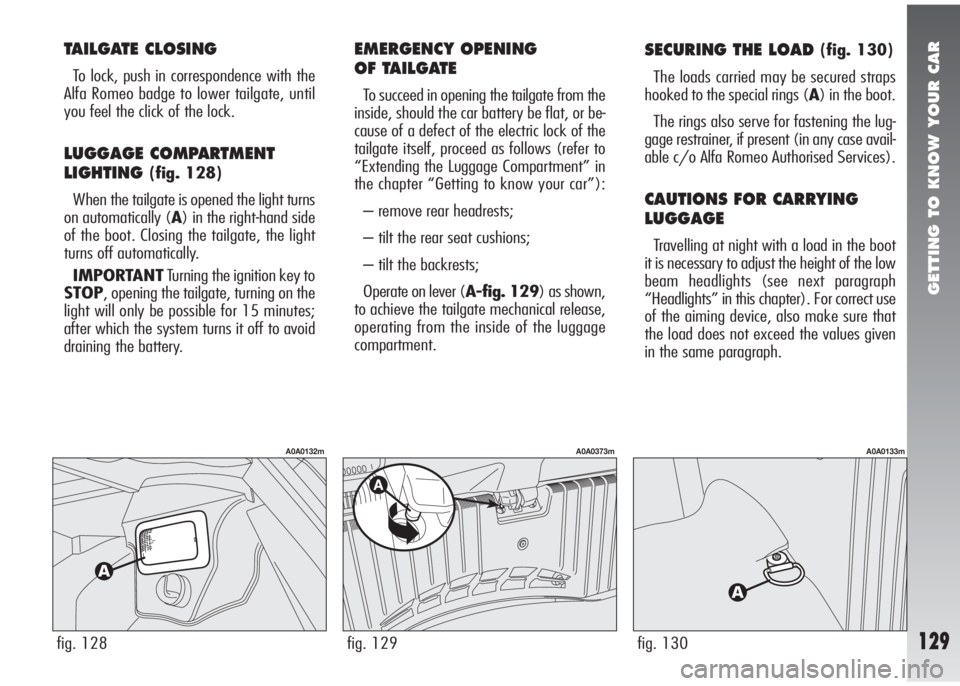
GETTING TO KNOW YOUR CAR
129fig. 128
A0A0132m
TAILGATE CLOSING
To lock, push in correspondence with the
Alfa Romeo badge to lower tailgate, until
you feel the click of the lock.
LUGGAGE COMPARTMENT
LIGHTING
(fig. 128)
When the tailgate is opened the light turns
on automatically (A) in the right-hand side
of the boot. Closing the tailgate, the light
turns off automatically.
IMPORTANTTurning the ignition key to
STOP, opening the tailgate, turning on the
light will only be possible for 15 minutes;
after which the system turns it off to avoid
draining the battery.
SECURING THE LOAD (fig. 130)
The loads carried may be secured straps
hooked to the special rings (A) in the boot.
The rings also serve for fastening the lug-
gage restrainer, if present (in any case avail-
able c/o Alfa Romeo Authorised Services).
CAUTIONS FOR CARRYING
LUGGAGE
Travelling at night with a load in the boot
it is necessary to adjust the height of the low
beam headlights (see next paragraph
“Headlights” in this chapter). For correct use
of the aiming device, also make sure that
the load does not exceed the values given
in the same paragraph.
fig. 130
A0A0133m
fig. 129
A0A0373m
EMERGENCY OPENING
OF TAILGATE
To succeed in opening the tailgate from the
inside, should the car battery be flat, or be-
cause of a defect of the electric lock of the
tailgate itself, proceed as follows (refer to
“Extending the Luggage Compartment” in
the chapter “Getting to know your car”):
– remove rear headrests;
– tilt the rear seat cushions;
– tilt the backrests;
Operate on lever (A-fig. 129) as shown,
to achieve the tailgate mechanical release,
operating from the inside of the luggage
compartment.
Page 132 of 291
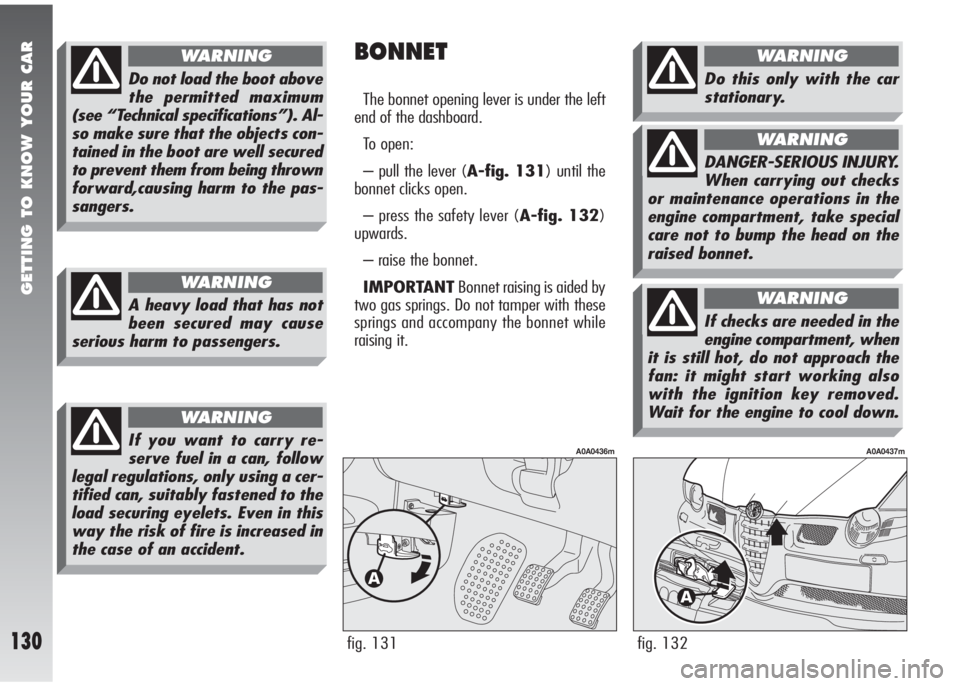
GETTING TO KNOW YOUR CAR
130fig. 132
A0A0437m
BONNET
The bonnet opening lever is under the left
end of the dashboard.
To open:
– pull the lever (A-fig. 131) until the
bonnet clicks open.
– press the safety lever (A-fig. 132)
upwards.
– raise the bonnet.
IMPORTANTBonnet raising is aided by
two gas springs. Do not tamper with these
springs and accompany the bonnet while
raising it.
fig. 131
A0A0436m
A heavy load that has not
been secured may cause
serious harm to passengers.
WARNING
Do not load the boot above
the permitted maximum
(see “Technical specifications”). Al-
so make sure that the objects con-
tained in the boot are well secured
to prevent them from being thrown
forward,causing harm to the pas-
sangers.
WARNING
If you want to carry re-
serve fuel in a can, follow
legal regulations, only using a cer-
tified can, suitably fastened to the
load securing eyelets. Even in this
way the risk of fire is increased in
the case of an accident.
WARNING
Do this only with the car
stationary.
WARNING
DANGER-SERIOUS INJURY.
When carrying out checks
or maintenance operations in the
engine compartment, take special
care not to bump the head on the
raised bonnet.
WARNING
If checks are needed in the
engine compartment, when
it is still hot, do not approach the
fan: it might start working also
with the ignition key removed.
Wait for the engine to cool down.
WARNING
Page 133 of 291
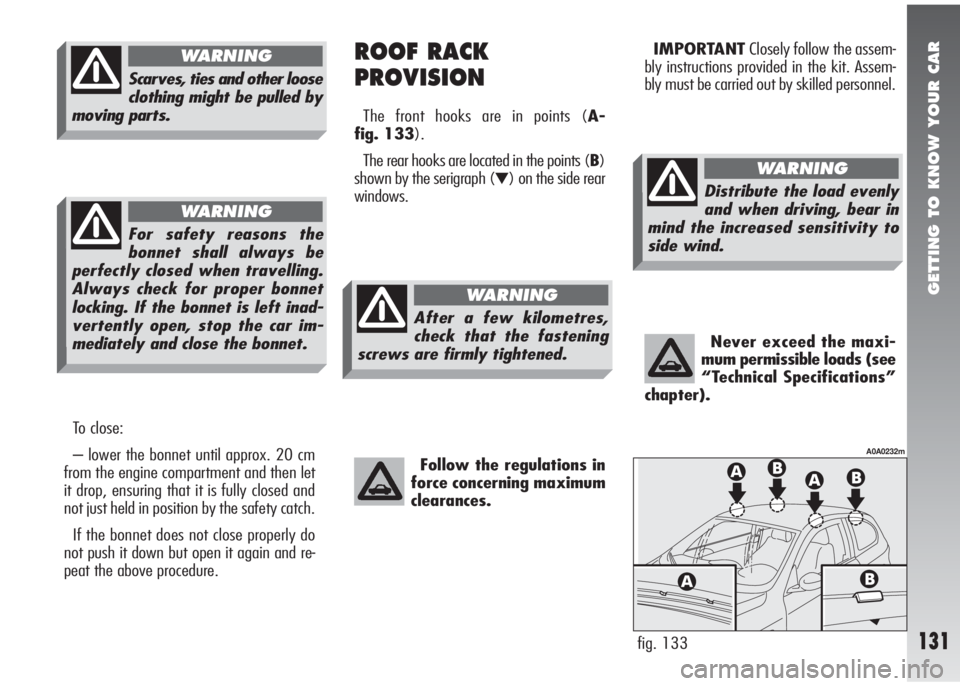
GETTING TO KNOW YOUR CAR
131
To close:
– lower the bonnet until approx. 20 cm
from the engine compartment and then let
it drop, ensuring that it is fully closed and
not just held in position by the safety catch.
If the bonnet does not close properly do
not push it down but open it again and re-
peat the above procedure.
Scarves, ties and other loose
clothing might be pulled by
moving parts.
WARNING
For safety reasons the
bonnet shall always be
perfectly closed when travelling.
Always check for proper bonnet
locking. If the bonnet is left inad-
vertently open, stop the car im-
mediately and close the bonnet.
WARNING
ROOF RACK
PROVISION
The front hooks are in points (A-
fig. 133).
The rear hooks are located in the points (B)
shown by the serigraph (
▼) on the side rear
windows.
Follow the regulations in
force concerning maximum
clearances.
IMPORTANTClosely follow the assem-
bly instructions provided in the kit. Assem-
bly must be carried out by skilled personnel.
Never exceed the maxi-
mum permissible loads (see
“Technical Specifications”
chapter).
fig. 133
A0A0232m
After a few kilometres,
check that the fastening
screws are firmly tightened.
WARNING
Distribute the load evenly
and when driving, bear in
mind the increased sensitivity to
side wind.
WARNING
Page 134 of 291

GETTING TO KNOW YOUR CAR
132fig. 135
A0A0199m
For correct adjustment, bear in mind the
following conditions:
– position 0: one or two people occupy-
ing the front seats
– position 1: five people;
– position 2: five people + load in the
boot;
– position 3: driver + maximum permis-
sible load all stowed in lug-
gage compartmentCOMPENSATION FOR TILT
(fig. 134)(excluding versions
with Xenon headlights)
When the vehicle is loaded, the beam from
the headlights is raised due to the back-
wards tilt of the vehicle.
In this case the headlights must be ad-
justed correctly.
To do this, use the rocker button (A), on
the plate at the side of the steering column:
– press the arrow on the button (
A), this
will increase by one position (eg.: 0
➟1
➟ 2➟3);
– press the arrow on the button (
S), this
will lower by one position (eg.: 3
➟2➟
1➟0);
The display (B), in the tachometer shows
the positions while adjustment is being
made.
fig. 134
A0A0467m
HEADLIGHTS
The adjustment of the headlights is vital to
your safety and comfort and to that of oth-
er road users.
The adjustment of the headlights is also
governed by precise regulations.
Contact Alfa Romeo Authorised Services to
have the headlights correctly adjusted.
IMPORTANTOn the inside surface of
the headlight there could appear a slight
coat of fogging; this does not show a defect,
since it is a natural occurrence due to low
temperature and to the degree of humidity
in the air; it will soon disappear as soon as
the lights are turned on. The presence of
drops inside the headlight shows water seep-
age, refer to the Alfa Romeo Dealership.
Check beam aiming every
time the load carried
changes.
WARNING
Page 135 of 291
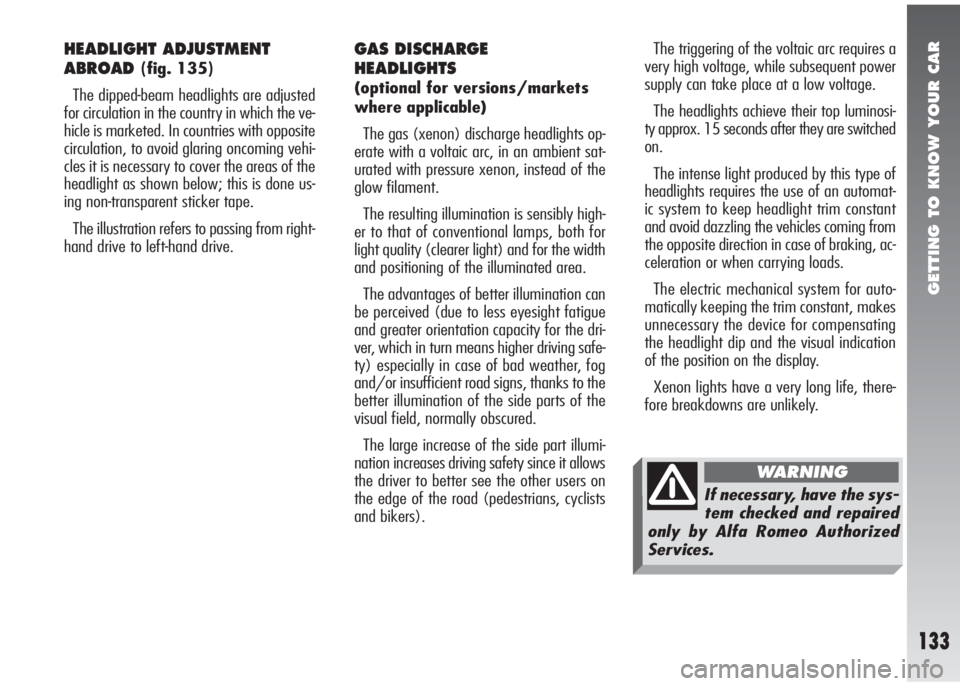
GETTING TO KNOW YOUR CAR
133
HEADLIGHT ADJUSTMENT
ABROAD
(fig. 135)
The dipped-beam headlights are adjusted
for circulation in the country in which the ve-
hicle is marketed. In countries with opposite
circulation, to avoid glaring oncoming vehi-
cles it is necessary to cover the areas of the
headlight as shown below; this is done us-
ing non-transparent sticker tape.
The illustration refers to passing from right-
hand drive to left-hand drive.
GAS DISCHARGE
HEADLIGHTS
(optional for versions/markets
where applicable)
The gas (xenon) discharge headlights op-
erate with a voltaic arc, in an ambient sat-
urated with pressure xenon, instead of the
glow filament.
The resulting illumination is sensibly high-
er to that of conventional lamps, both for
light quality (clearer light) and for the width
and positioning of the illuminated area.
The advantages of better illumination can
be perceived (due to less eyesight fatigue
and greater orientation capacity for the dri-
ver, which in turn means higher driving safe-
ty) especially in case of bad weather, fog
and/or insufficient road signs, thanks to the
better illumination of the side parts of the
visual field, normally obscured.
The large increase of the side part illumi-
nation increases driving safety since it allows
the driver to better see the other users on
the edge of the road (pedestrians, cyclists
and bikers).The triggering of the voltaic arc requires a
very high voltage, while subsequent power
supply can take place at a low voltage.
The headlights achieve their top luminosi-
ty approx. 15 seconds after they are switched
on.
The intense light produced by this type of
headlights requires the use of an automat-
ic system to keep headlight trim constant
and avoid dazzling the vehicles coming from
the opposite direction in case of braking, ac-
celeration or when carrying loads.
The electric mechanical system for auto-
matically keeping the trim constant, makes
unnecessary the device for compensating
the headlight dip and the visual indication
of the position on the display.
Xenon lights have a very long life, there-
fore breakdowns are unlikely.
If necessary, have the sys-
tem checked and repaired
only by Alfa Romeo Authorized
Services.
WARNING
Page 136 of 291
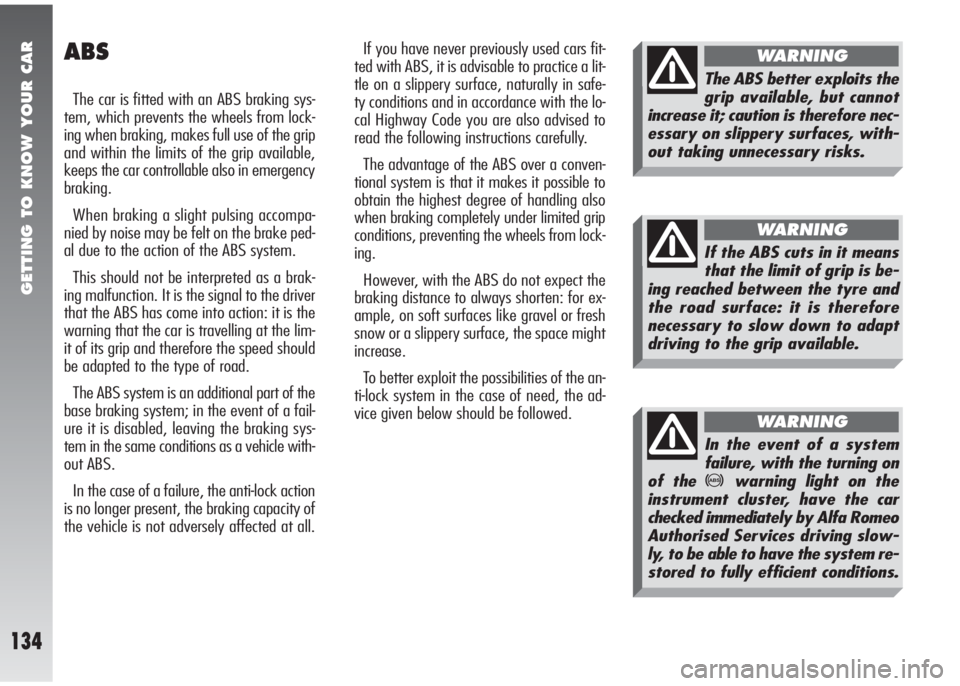
GETTING TO KNOW YOUR CAR
134
ABS
The car is fitted with an ABS braking sys-
tem, which prevents the wheels from lock-
ing when braking, makes full use of the grip
and within the limits of the grip available,
keeps the car controllable also in emergency
braking.
When braking a slight pulsing accompa-
nied by noise may be felt on the brake ped-
al due to the action of the ABS system.
This should not be interpreted as a brak-
ing malfunction. It is the signal to the driver
that the ABS has come into action: it is the
warning that the car is travelling at the lim-
it of its grip and therefore the speed should
be adapted to the type of road.
The ABS system is an additional part of the
base braking system; in the event of a fail-
ure it is disabled, leaving the braking sys-
tem in the same conditions as a vehicle with-
out ABS.
In the case of a failure, the anti-lock action
is no longer present, the braking capacity of
the vehicle is not adversely affected at all.If you have never previously used cars fit-
ted with ABS, it is advisable to practice a lit-
tle on a slippery surface, naturally in safe-
ty conditions and in accordance with the lo-
cal Highway Code you are also advised to
read the following instructions carefully.
The advantage of the ABS over a conven-
tional system is that it makes it possible to
obtain the highest degree of handling also
when braking completely under limited grip
conditions, preventing the wheels from lock-
ing.
However, with the ABS do not expect the
braking distance to always shorten: for ex-
ample, on soft surfaces like gravel or fresh
snow or a slippery surface, the space might
increase.
To better exploit the possibilities of the an-
ti-lock system in the case of need, the ad-
vice given below should be followed.
If the ABS cuts in it means
that the limit of grip is be-
ing reached between the tyre and
the road surface: it is therefore
necessary to slow down to adapt
driving to the grip available.
WARNING
The ABS better exploits the
grip available, but cannot
increase it; caution is therefore nec-
essary on slippery surfaces, with-
out taking unnecessary risks.
WARNING
In the event of a system
failure, with the turning on
of the
>warning light on the
instrument cluster, have the car
checked immediately by Alfa Romeo
Authorised Services driving slow-
ly, to be able to have the system re-
stored to fully efficient conditions.
WARNING
Page 137 of 291
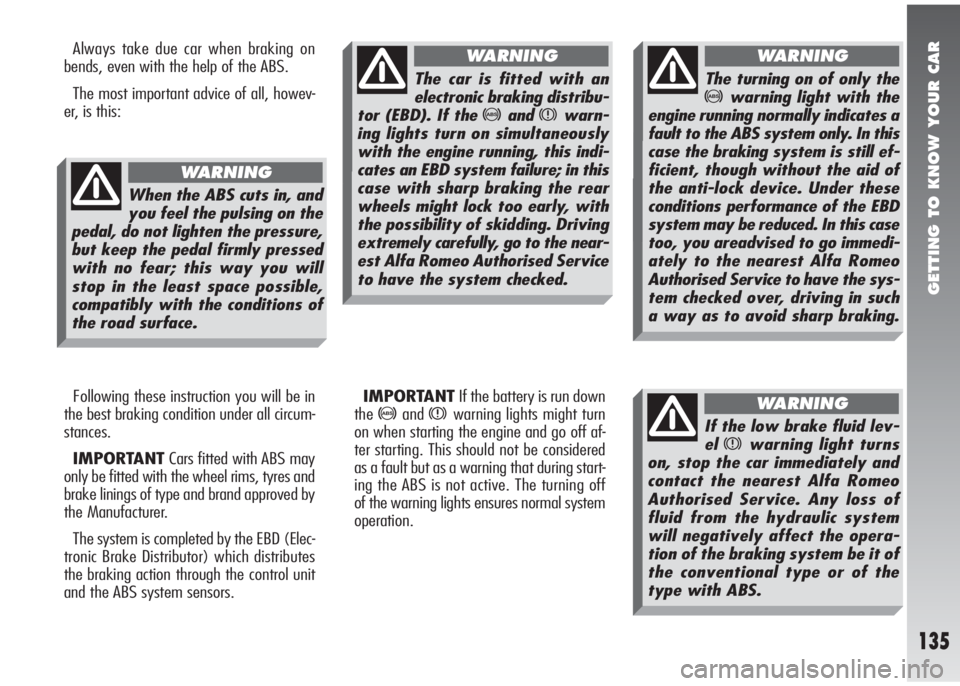
GETTING TO KNOW YOUR CAR
135
Always take due car when braking on
bends, even with the help of the ABS.
The most important advice of all, howev-
er, is this:
Following these instruction you will be in
the best braking condition under all circum-
stances.
IMPORTANTCars fitted with ABS may
only be fitted with the wheel rims, tyres and
brake linings of type and brand approved by
the Manufacturer.
The system is completed by the EBD (Elec-
tronic Brake Distributor) which distributes
the braking action through the control unit
and the ABS system sensors.IMPORTANTIf the battery is run down
the
>andxwarning lights might turn
on when starting the engine and go off af-
ter starting. This should not be considered
as a fault but as a warning that during start-
ing the ABS is not active. The turning off
of the warning lights ensures normal system
operation.
When the ABS cuts in, and
you feel the pulsing on the
pedal, do not lighten the pressure,
but keep the pedal firmly pressed
with no fear; this way you will
stop in the least space possible,
compatibly with the conditions of
the road surface.
WARNING
The car is fitted with an
electronic braking distribu-
tor (EBD). If the
>andxwarn-
ing lights turn on simultaneously
with the engine running, this indi-
cates an EBD system failure; in this
case with sharp braking the rear
wheels might lock too early, with
the possibility of skidding. Driving
extremely carefully, go to the near-
est Alfa Romeo Authorised Service
to have the system checked.
WARNING
The turning on of only the
>warning light with the
engine running normally indicates a
fault to the ABS system only. In this
case the braking system is still ef-
ficient, though without the aid of
the anti-lock device. Under these
conditions performance of the EBD
system may be reduced. In this case
too, you areadvised to go immedi-
ately to the nearest Alfa Romeo
Authorised Service to have the sys-
tem checked over, driving in such
a way as to avoid sharp braking.
WARNING
If the low brake fluid lev-
el
xwarning light turns
on, stop the car immediately and
contact the nearest Alfa Romeo
Authorised Service. Any loss of
fluid from the hydraulic system
will negatively affect the opera-
tion of the braking system be it of
the conventional type or of the
type with ABS.
WARNING
Page 138 of 291
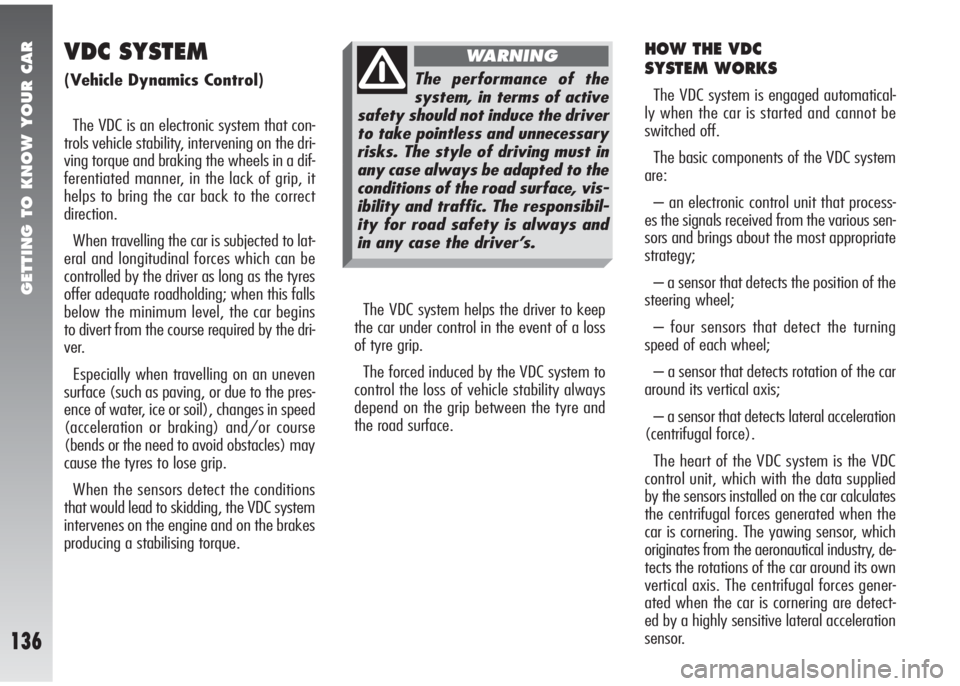
GETTING TO KNOW YOUR CAR
136
VDC SYSTEM
(Vehicle Dynamics Control)
The VDC is an electronic system that con-
trols vehicle stability, intervening on the dri-
ving torque and braking the wheels in a dif-
ferentiated manner, in the lack of grip, it
helps to bring the car back to the correct
direction.
When travelling the car is subjected to lat-
eral and longitudinal forces which can be
controlled by the driver as long as the tyres
offer adequate roadholding; when this falls
below the minimum level, the car begins
to divert from the course required by the dri-
ver.
Especially when travelling on an uneven
surface (such as paving, or due to the pres-
ence of water, ice or soil), changes in speed
(acceleration or braking) and/or course
(bends or the need to avoid obstacles) may
cause the tyres to lose grip.
When the sensors detect the conditions
that would lead to skidding, the VDC system
intervenes on the engine and on the brakes
producing a stabilising torque.
HOW THE VDC
SYSTEM WORKS
The VDC system is engaged automatical-
ly when the car is started and cannot be
switched off.
The basic components of the VDC system
are:
– an electronic control unit that process-
es the signals received from the various sen-
sors and brings about the most appropriate
strategy;
– a sensor that detects the position of the
steering wheel;
– four sensors that detect the turning
speed of each wheel;
– a sensor that detects rotation of the car
around its vertical axis;
– a sensor that detects lateral acceleration
(centrifugal force).
The heart of the VDC system is the VDC
control unit, which with the data supplied
by the sensors installed on the car calculates
the centrifugal forces generated when the
car is cornering. The yawing sensor, which
originates from the aeronautical industry, de-
tects the rotations of the car around its own
vertical axis. The centrifugal forces gener-
ated when the car is cornering are detect-
ed by a highly sensitive lateral acceleration
sensor. The VDC system helps the driver to keep
the car under control in the event of a loss
of tyre grip.
The forced induced by the VDC system to
control the loss of vehicle stability always
depend on the grip between the tyre and
the road surface.
The performance of the
system, in terms of active
safety should not induce the driver
to take pointless and unnecessary
risks. The style of driving must in
any case always be adapted to the
conditions of the road surface, vis-
ibility and traffic. The responsibil-
ity for road safety is always and
in any case the driver’s.
WARNING
Page 139 of 291
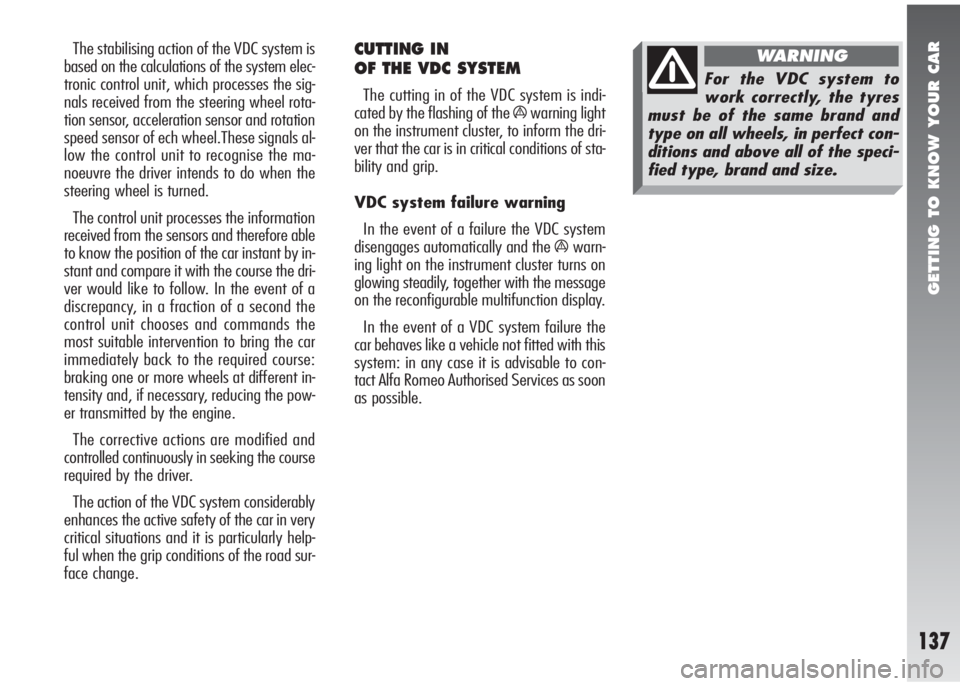
GETTING TO KNOW YOUR CAR
137
The stabilising action of the VDC system is
based on the calculations of the system elec-
tronic control unit, which processes the sig-
nals received from the steering wheel rota-
tion sensor, acceleration sensor and rotation
speed sensor of ech wheel.These signals al-
low the control unit to recognise the ma-
noeuvre the driver intends to do when the
steering wheel is turned.
The control unit processes the information
received from the sensors and therefore able
to know the position of the car instant by in-
stant and compare it with the course the dri-
ver would like to follow. In the event of a
discrepancy, in a fraction of a second the
control unit chooses and commands the
most suitable intervention to bring the car
immediately back to the required course:
braking one or more wheels at different in-
tensity and, if necessary, reducing the pow-
er transmitted by the engine.
The corrective actions are modified and
controlled continuously in seeking the course
required by the driver.
The action of the VDC system considerably
enhances the active safety of the car in very
critical situations and it is particularly help-
ful when the grip conditions of the road sur-
face change.CUTTING IN
OF THE VDC SYSTEM
The cutting in of the VDC system is indi-
cated by the flashing of the
áwarning light
on the instrument cluster, to inform the dri-
ver that the car is in critical conditions of sta-
bility and grip.
VDC system failure warning
In the event of a failure the VDC system
disengages automatically and the
áwarn-
ing light on the instrument cluster turns on
glowing steadily, together with the message
on the reconfigurable multifunction display.
In the event of a VDC system failure the
car behaves like a vehicle not fitted with this
system: in any case it is advisable to con-
tact Alfa Romeo Authorised Services as soon
as possible.
For the VDC system to
work correctly, the tyres
must be of the same brand and
type on all wheels, in perfect con-
ditions and above all of the speci-
fied type, brand and size.
WARNING
Page 140 of 291

GETTING TO KNOW YOUR CAR
138
SWITCHING ON
THE ASR FUNCTION
The ASR function switches on automati-
cally each time the engine is started.
When travelling the device can be switched
off and on again pressing switch (A-
fig. 136) on the centre console.
Function disconnection is shown by the rel-
evant led on the switch itself being turned
on and by the dedicated message displayed
on the re-configurable multifunction display.
Should the function be disconnected when
running, it will automatically be activated
again at the next ignition and the re-con-
figurable multifunction display will inform
user about this condition by displaying a ded-
icated message.
fig. 136
A0A0140m
ASR SYSTEM
(Antislip Regulation)
The ASR function controls the vehicle dri-
ve and cuts in automatically every time one
or both driving wheels slip.
In slipping conditions, two different control
systems are activated:
1) if slipping involves both driving wheels,
being caused by excessive power transmit-
ted, the ASR device cuts in reducing the pow-
er transmitted by the engine.
2) if slipping involves only one driving
wheel, the ASR system cuts in automatical-
ly braking the wheel that is slipping, with
an effect similar to that of a self-locking dif-
ferential.
The action of the ASR is particularly help-
ful in the following circumstances:
– slipping of the inner wheel on a bend,
due to the effect of dynamic load changes
or excessive acceleration.
– too much power transmitted to the
wheels also in relation to the conditions of
the road surface.
– acceleration on slippery, snowy or frozen
surfaces.
– in the case of loss of grip on a wet sur-
face (aquaplaning).The performance of the
system in terms of active
safety should not induce the driver
to take pointless and unnecessary
risks. The style of driving must in
any case be adapted to the condi-
tions of the road surface, visibili-
ty and traffic. Road safety is al-
ways the driver’s responsibility.
WARNING